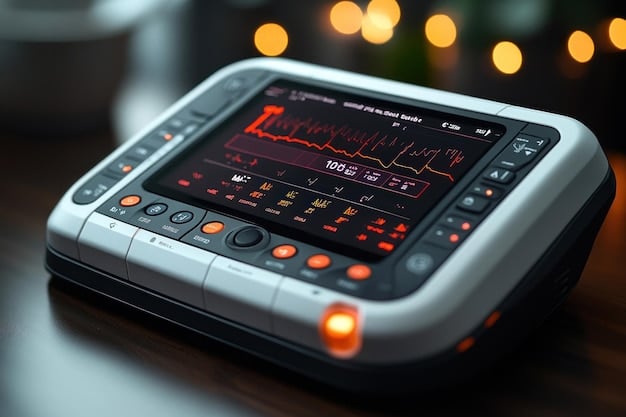Biofeedback for Anxiety: A Data-Driven Look at Its Effectiveness

Biofeedback training may reduce anxiety symptoms by helping individuals gain awareness and control over their physiological responses to stress, as current studies suggest.
Can biofeedback training reduce anxiety? Many individuals seek non-pharmacological approaches to manage their anxiety symptoms. This article explores whether biofeedback is a viable, science-backed solution.
Understanding Anxiety and Its Impact
Anxiety is a common emotion characterized by feelings of tension, worried thoughts, and physical changes like increased blood pressure. While occasional anxiety is a normal part of life, persistent and excessive anxiety can develop into anxiety disorders, which can significantly impair daily functioning.
Prevalence of Anxiety Disorders
Anxiety disorders are among the most prevalent mental health conditions worldwide, affecting millions of people. Understanding the scope of the problem is crucial in seeking effective interventions.
- According to the Anxiety & Depression Association of America (ADAA), anxiety disorders affect 40 million adults in the United States aged 18 and older, representing 19.1% of the population.
- Globally, anxiety disorders are also widespread, with varying prevalence rates across different countries and regions.
- These disorders include generalized anxiety disorder (GAD), social anxiety disorder (SAD), panic disorder, phobias, and separation anxiety disorder, among others.
The Physiological Effects of Anxiety
Anxiety is not just a mental experience; it also has profound effects on the body. Understanding these physiological manifestations can help individuals recognize and manage their anxiety responses more effectively. Chronic anxiety can lead to long-term health problems, underscoring the importance of effective management strategies.
- Increased heart rate and blood pressure: Anxiety triggers the body’s fight-or-flight response, leading to an elevated heart rate and blood pressure.
- Muscle tension: Chronic anxiety often results in persistent muscle tension, which can cause headaches, body aches, and fatigue.
- Digestive issues: Anxiety can disrupt the digestive system, leading to symptoms like stomachaches, nausea, diarrhea, or constipation.
- Sleep disturbances: Many individuals with anxiety experience difficulty falling asleep or staying asleep, leading to insomnia and daytime fatigue.
In conclusion, anxiety disorders are widespread conditions with significant physiological effects. Recognizing the prevalence and impact of anxiety is essential for promoting early intervention and effective management strategies.
What is Biofeedback Training?
Biofeedback training is a technique that empowers individuals to gain awareness of various physiological functions, such as brainwaves, heart rate, muscle tension, and skin temperature. By receiving real-time feedback from specialized instruments, individuals can learn to consciously regulate these functions, with the goal of improving overall health and well-being.
How Biofeedback Works
Biofeedback works by providing individuals with immediate and continuous information about their physiological responses. This feedback loop enables them to develop a greater understanding of how their body responds to stress and other stimuli. Ultimately, individuals can learn to exert conscious control over these responses, promoting relaxation and reducing anxiety.
- Sensors are attached to the body to monitor physiological functions such as heart rate, muscle tension, or brainwave activity.
- The sensors transmit data to a biofeedback machine, which processes the information and provides real-time feedback to the individual.
- The feedback can be presented in various forms, such as visual displays, auditory signals, or tactile sensations.
Different Types of Biofeedback
Several types of biofeedback techniques can address specific physiological functions. The choice of biofeedback method depends on the individual’s needs and the specific symptoms they are trying to manage. Exploring the variety of biofeedback options allows individuals to find the best approach for their unique situation and goals. Each type of biofeedback offers unique benefits and applications.
- Electromyography (EMG): Measures muscle tension and is often used to treat tension headaches, back pain, and temporomandibular joint (TMJ) disorders.
- Electroencephalography (EEG): Monitors brainwave activity and is utilized to address conditions such as ADHD, epilepsy, and anxiety disorders.
- Heart Rate Variability (HRV) Biofeedback: Focuses on the variability in time intervals between heartbeats, used to improve cardiovascular health and regulate emotional responses.
- Thermal Biofeedback: Measures skin temperature, often employed to manage conditions like migraines and Raynaud’s syndrome.

In summary, biofeedback training is a powerful technique that allows individuals to gain control over their physiological functions. By understanding how biofeedback works and exploring different types, individuals can make informed decisions about incorporating this therapy into their anxiety management plan.
The Science Behind Biofeedback and Anxiety Reduction
The effectiveness of biofeedback training in reducing anxiety is supported by various studies that explore the physiological and psychological mechanisms involved. Understanding these scientific underpinnings can provide confidence in the potential benefits of biofeedback for anxiety management.
Physiological Mechanisms
Biofeedback influences several physiological systems, promoting relaxation and reducing the physical symptoms of anxiety. These mechanisms contribute to the overall sense of well-being and reduced anxiety levels experienced by individuals undergoing biofeedback training.
- Regulation of the Autonomic Nervous System: Biofeedback can help regulate the autonomic nervous system, which controls involuntary functions like heart rate, blood pressure, and breathing.
- Reduction of Muscle Tension: EMG biofeedback can reduce muscle tension, a common symptom of anxiety, by helping individuals become aware of and consciously relax their muscles.
- Modulation of Brainwave Activity: EEG biofeedback can modulate brainwave activity, promoting a more relaxed and focused state of mind.
Psychological Mechanisms
In addition to its physiological effects, biofeedback also impacts psychological processes related to anxiety. These psychological mechanisms, combined with the physiological benefits, make biofeedback a comprehensive approach to anxiety management.
- Enhanced Self-Awareness: Biofeedback increases self-awareness of bodily sensations and responses, allowing individuals to recognize early signs of anxiety and take proactive steps to manage them.
- Increased Sense of Control: By learning to regulate physiological functions, individuals gain a greater sense of control over their anxiety, which can reduce feelings of helplessness and fear.
- Cognitive Restructuring: Biofeedback can be combined with cognitive techniques to challenge and change negative thought patterns associated with anxiety.
In conclusion, the science behind biofeedback and anxiety reduction involves both physiological and psychological mechanisms. By regulating the autonomic nervous system, reducing muscle tension, modulating brainwave activity, and enhancing self-awareness, biofeedback offers a comprehensive approach to managing anxiety symptoms.
Analyzing Current Studies on Biofeedback for Anxiety
Numerous studies have investigated the effectiveness of biofeedback training in reducing anxiety symptoms. Analyzing these studies provides valuable insights into the strengths and limitations of biofeedback as an anxiety management tool.
Key Findings from Research Studies
Research studies on biofeedback for anxiety have yielded promising results, indicating that biofeedback can be an effective intervention for reducing anxiety symptoms. Examining the specific findings from these studies helps to understand the scope and nature of biofeedback’s benefits.
- A meta-analysis published in the journal Applied Psychophysiology and Biofeedback found that biofeedback was effective in reducing anxiety symptoms across various anxiety disorders.
- Another study in the Journal of Consulting and Clinical Psychology demonstrated that HRV biofeedback significantly reduced anxiety and improved emotional regulation in participants with generalized anxiety disorder.
- Research has also shown that EMG biofeedback can be effective in reducing muscle tension and anxiety in individuals with tension headaches.
Limitations and Future Directions
While the evidence supporting biofeedback for anxiety is encouraging, it is essential to acknowledge the limitations of current research. Addressing these limitations in future studies can further enhance the understanding and application of biofeedback for anxiety management.
- Sample Size and Diversity: Some studies have small sample sizes or lack diversity, limiting the generalizability of the findings.
- Control Groups: The effectiveness of biofeedback compared to other treatments or placebo effects needs further investigation through well-designed controlled trials.
- Long-Term Effects: More research is needed to assess the long-term benefits of biofeedback and its sustainability over time.

In summary, current studies on biofeedback for anxiety indicate that it shows promise as an effective intervention. While there are limitations to consider, ongoing research and improvements in study design can further validate and expand the application of biofeedback in managing anxiety disorders.
Practical Applications of Biofeedback for Anxiety Management
Biofeedback training can be integrated into various settings and combined with other therapeutic approaches to enhance its effectiveness in anxiety management. Understanding these practical applications can help individuals and healthcare professionals implement biofeedback effectively.
Integrating Biofeedback into Therapy
Biofeedback is often used as part of a comprehensive treatment plan for anxiety, complementing other therapeutic techniques. Integrating biofeedback with therapy can lead to more holistic and effective outcomes for individuals struggling with anxiety.
- Cognitive Behavioral Therapy (CBT): Combining biofeedback with CBT can help individuals identify and change negative thought patterns while also learning to regulate their physiological responses to stress.
- Mindfulness-Based Stress Reduction (MBSR): Integrating biofeedback with MBSR can enhance self-awareness and promote relaxation, leading to greater stress reduction and emotional well-being.
- Medication Management: Biofeedback can be used in conjunction with medication to help individuals reduce their reliance on medication and manage anxiety symptoms more effectively.
Finding a Qualified Biofeedback Therapist
To ensure the safety and effectiveness of biofeedback training, it is essential to work with a qualified and experienced therapist. Proper training assures that the therapist is competent in providing biofeedback and can tailor the treatment to meet individual needs.
- Look for therapists who are certified by the Biofeedback Certification International Alliance (BCIA).
- Check the therapist’s credentials, experience, and areas of specialization.
- Ask about the therapist’s approach to biofeedback and how they integrate it with other therapeutic techniques.
In conclusion, biofeedback can be practically applied in various settings and integrated with other therapies for effective anxiety management. Finding a qualified therapist and integrating biofeedback into a comprehensive treatment plan are crucial steps in harnessing its full potential.
Lifestyle Changes to Support Biofeedback Training
While biofeedback training can be a powerful tool for anxiety management, its effectiveness can be enhanced by incorporating supportive lifestyle changes. These changes can help regulate physiological responses, promote relaxation, and improve overall well-being.
Diet and Nutrition
A balanced diet can significantly impact anxiety levels and support the benefits of biofeedback training. Making informed dietary choices can help regulate mood, reduce stress, and improve overall mental health.
- Limit processed foods, sugary drinks, and caffeine, as these can exacerbate anxiety symptoms.
- Include foods rich in omega-3 fatty acids, such as fish, flaxseeds, and walnuts, which have been shown to reduce anxiety and improve mood.
- Consume a variety of fruits, vegetables, and whole grains to provide essential nutrients and support overall health.
Exercise and Physical Activity
Regular exercise is a well-known stress reliever and can complement biofeedback training in reducing anxiety. Engaging in physical activity can release endorphins, improve mood, and promote relaxation.
- Aim for at least 30 minutes of moderate-intensity exercise most days of the week, such as walking, jogging, swimming, or cycling.
- Incorporate activities that you enjoy, as this will make it easier to stick to a regular exercise routine.
- Consider practicing yoga or tai chi, which combine physical activity with relaxation and mindfulness techniques.
In summary, supportive lifestyle changes, including a balanced diet and regular exercise, can enhance the effectiveness of biofeedback training for anxiety management. By addressing both physiological and lifestyle factors, individuals can achieve greater and more sustainable reductions in anxiety symptoms.
| Key Point | Brief Description |
|---|---|
| 🧠 Biofeedback | Technique to control physiological functions. |
| 📊 Research | Studies support its anxiety-reducing effectiveness. |
| 🧘 Lifestyle | Diet and exercise enhance biofeedback benefits. |
Frequently Asked Questions
▼
The main goal is to teach individuals to become aware of and gain control over their physiological functions like heart rate, muscle tension, and brainwave activity to improve health.
▼
Biofeedback helps reduce anxiety by enabling individuals to consciously regulate their physiological responses to stress, promoting relaxation and reducing the physical symptoms of anxiety.
▼
Biofeedback can help manage various anxiety disorders, including generalized anxiety disorder, social anxiety disorder, panic disorder, and specific phobias, addressing the unique physiological and psychological aspects of each.
▼
The time it takes to see results with biofeedback varies, but many individuals experience noticeable improvements within 8 to 10 sessions. Consistency and regular practice are key to achieving lasting benefits.
▼
Yes, biofeedback training is generally considered safe when performed by a qualified and certified therapist. It is a non-invasive technique with few to no side effects when applied correctly.
Conclusion
In conclusion, the evidence suggests that biofeedback training can be a valuable tool in reducing anxiety symptoms. By understanding the scientific basis, practical applications, and supportive lifestyle changes, individuals can make informed decisions about incorporating biofeedback into their anxiety management plan and work towards a healthier, more balanced life.





